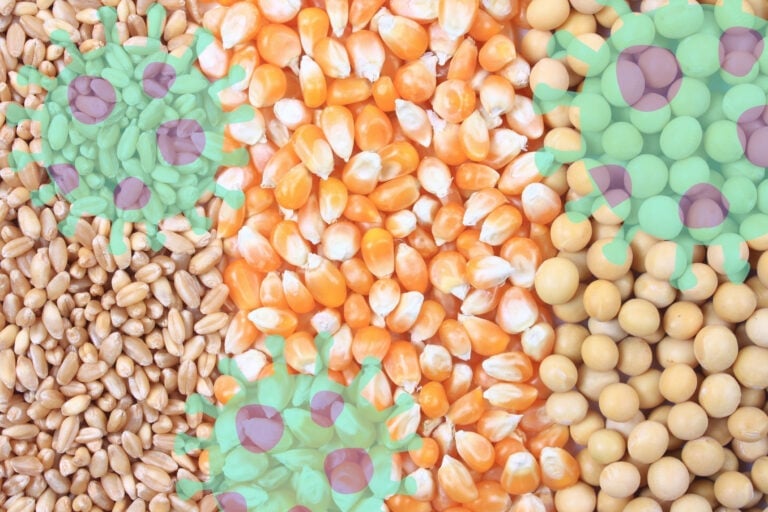December 7, 2025 | 17:46 GMT +7
December 7, 2025 | 17:46 GMT +7
Hotline: 0913.378.918
December 7, 2025 | 17:46 GMT +7
Hotline: 0913.378.918

The findings show that addressing mycotoxin contamination in feed crops such as wheat, maize and soybean is important for achieving sustainable, low-carbon and profitable poultry production. Photo: Canva.
Ground-breaking research from Queen’s University Belfast demonstrates that harmful chemicals in mycotoxins can negatively affect both the environmental and economic sustainability of the global poultry industry by contaminating animal feed.
The researchers found that mycotoxins in feed pose a significant challenge for livestock farmers worldwide. These toxins can substantially reduce profitability, increase food waste, and decrease food production. In poultry, mycotoxin contamination can reduce feed efficiency by up to 10%, potentially resulting in losses of more than £150,000 per year for a medium-scale operation. Additionally, mycotoxins negatively impact bird health, including increased mortality rates.
Economic and environmental impact of mycotoxins
Professor Chris Elliot from the School of Biological Sciences and Institute for Global Food Security at Queen’s University, Belfast, said that while the effects of mycotoxins had been extensively studied, comprehensive research quantifying their combined economic and environmental impacts remains limited.
“This study is extremely significant as it addresses an important research gap by evaluating the potential economic and environmental consequences of the rearing of chickens specifically for meat consumption using mycotoxin-contaminated feeds, a widespread issue globally,” he said.
Elliot added: “The findings show that addressing mycotoxin contamination in feed crops such as wheat, maize and soybean is important for achieving sustainable, low-carbon and profitable poultry production.”
Mycotoxins and carbon footprint of poultry
The study, which saw collaboration from DSM-Firmenich Animal Nutrition and Health and BOKU University, Vienna, and the Austrian Competence Centre for Feed and Food Quality, Safety and Innovation, showed that even very low levels of mycotoxins can increase the carbon footprint of poultry production by more than 8%.
Co-author, Professor Rudi Krska from the School of Biological Sciences and Institute for Global Food Security at Queen’s and BOKU University, added that the study would have a great impact and would likely lead to changes in how the agri-food industry will view low-level mycotoxin contamination.
“These data are of substantial importance to the poultry industry, and we envisage that it will drive economic and environmental sustainability of the world’s most widely consumed animal protein. We believe that farmers, consumers and the planet will all benefit.”
How can we control mycotoxins? What is the mycotoxins risk per region? What is the impact of mycotoxins? Visit All About Feed to learn all about MYCOTOXINS.
The importance of effective and consistent mycotoxin risk management
Dr Gerd Schatzmayr, head of global R&D centres at DSM-Firmenich Animal Nutrition and Health and fellow co-author, said the economic stakes were substantial: “In an era where climate volatility and global trade disruptions increasingly challenge poultry production, the economic stakes are higher than ever.
“This underscores the critical need for safe, science-backed mycotoxin mitigation strategies. Effective and consistent mycotoxin risk management not only supports animal health and welfare but also strengths farm profitability, sustainability and food security.”
(Poultryworld)

(VAN) At the TARASA25 Conference, participating countries shared experiences on implementing agroecology and regenerative agriculture, contributing to a sustainable transformation of food and agriculture systems.

(VAN) Green industry is becoming a driving force for the development of Hue City, not only promoting economic growth but also protecting the environment, creating the foundation for the Net Zero goal.

(VAN) As of 2025, the ASEAN region has a total of 69 ASEAN Heritage Parks recognized across its 10 member states. Among them, Viet Nam contributes 15 ASEAN Heritage Parks.

(VAN) Yok Don National Park has high biodiversity with numerous endemic plant and animal species, and it is also the only dipterocarp forest ecosystem conservation area in Viet Nam.

(VAN) Viet Nam and Brunei signed two important MOUs on fisheries and IUU, expanding cooperation in agriculture, the environment, and Halal exports, aiming to substantively implement joint projects.

(VAN) The Viet Nam Coconut Association worked with the International Finance Corporation (IFC) and businesses to promote the supply chain, enhance competitiveness, and develop the coconut industry sustainably.
![Hue aims for Net Zero: [2] Pioneering low-emission tourism](https://t.ex-cdn.com/nongnghiepmoitruong.vn/608w/files/huytd/2025/12/04/0633-dulichzero-4-095634_236-161125.jpg)
(VAN) The ancient capital of Hue has developed Net Zero tourism products and models, aiming to reduce carbon emissions and pioneer the establishment of Viet Nam's green tourism destination.